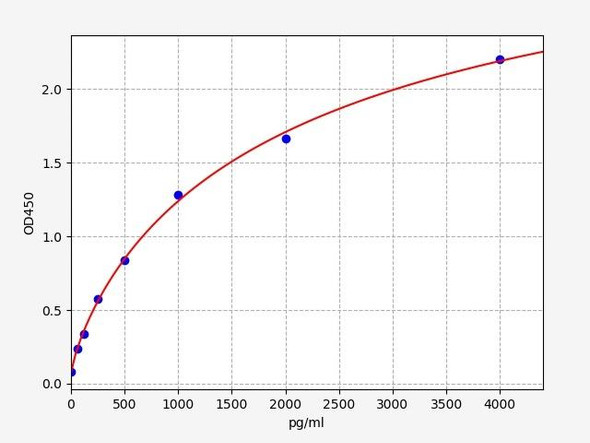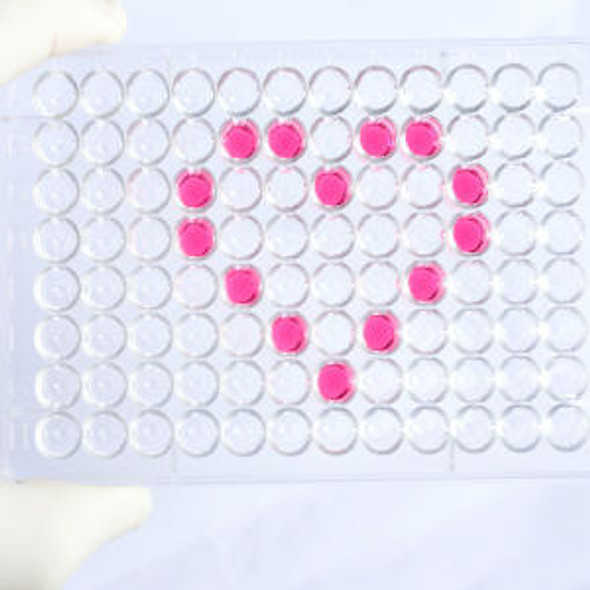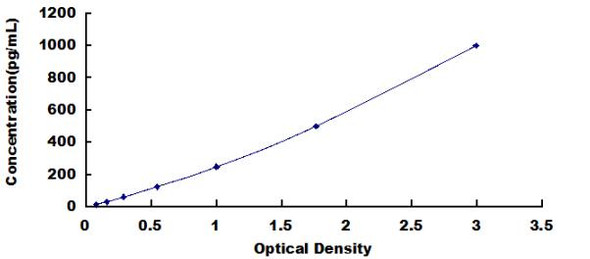Human Cell Biology ELISA Kits 3
Human ARR beta2 (Arrestin Beta 2) CLIA Kit (HUES00358)
- SKU:
- HUES00358
- Product Type:
- ELISA Kit
- ELISA Type:
- CLIA Kit
- Size:
- 96 Assays
- Sensitivity:
- 46.88pg/mL
- Range:
- 78.13-5000pg/mL
- ELISA Type:
- Sandwich
- Reactivity:
- Human
- Sample Type:
- Serum, plasma and other biological fluids
- Research Area:
- Cell Biology
Description
| Assay type: | Sandwich |
| Format: | 96T |
| Assay time: | 4.5h |
| Reactivity: | Human |
| Detection method: | Chemiluminescence |
| Detection range: | 78.13-5000 pg/mL |
| Sensitivity: | 46.88 pg/mL |
| Sample volume: | 100µL |
| Sample type: | Serum, plasma and other biological fluids |
| Repeatability: | CV < 15% |
| Specificity: | This kit recognizes Human ARR beta2 in samples. No significant cross-reactivity or interference between Human ARR beta2 and analogues was observed. |
This kit uses Sandwich-CLIA as the method. The micro CLIA plate provided in this kit has been pre-coated with an antibody specific to Human ARR beta2. Standards or samples are added to the appropriate micro CLIA plate wells and combined with the specific antibody. Then a biotinylated detection antibody specific for Human ARR beta2 and Avidin-Horseradish Peroxidase (HRP) conjugate are added to each micro plate well successively and incubated. Free components are washed away. The substrate solution is added to each well. Only those wells that contain Human ARR beta2, biotinylated detection antibody and Avidin-HRP conjugate will appear fluorescence. The Relative light unit (RLU) value is measured spectrophotometrically by the Chemiluminescence immunoassay analyzer. The RLU value is positively associated with the concentration of Human ARR beta2. The concentration of Human ARR beta2 in the samples can be calculated by comparing the RLU of the samples to the standard curve.
| UniProt Protein Function: | ARRB2: a member of the arrestin/beta-arrestin protein family. These proteins participate in agonist-mediated desensitization of G-protein-coupled receptors. Acts as a cofactor in the beta-adrenergic receptor kinase (BARK) mediated desensitization of beta-adrenergic receptors. Expressed at high levels in the CNS and peripheral blood leukocytes. |
| UniProt Protein Details: | Protein type:Adaptor/scaffold Chromosomal Location of Human Ortholog: 17p13 Cellular Component: postsynaptic membrane; endocytic vesicle; basolateral plasma membrane; postsynaptic density; cytoplasm; plasma membrane; dendritic spine; coated pit; cytoplasmic vesicle; cytosol; nucleus Molecular Function:angiotensin receptor binding; protein domain specific binding; protein kinase B binding; type 2A serotonin receptor binding; follicle stimulating hormone receptor binding; alpha-1B adrenergic receptor binding; alpha-1A adrenergic receptor binding; protein binding; enzyme binding; G-protein-coupled receptor binding; ubiquitin protein ligase binding; protein complex binding; mitogen-activated protein kinase binding; type 1 angiotensin receptor binding; protein complex scaffold; D1 dopamine receptor binding; receptor binding Biological Process: transcription from RNA polymerase II promoter; proteasomal ubiquitin-dependent protein catabolic process; follicle-stimulating hormone signaling pathway; positive regulation of receptor internalization; protein ubiquitination; negative regulation of caspase activity; adult walking behavior; protein transport; receptor internalization; transforming growth factor beta receptor signaling pathway; negative regulation of interleukin-6 production; detection of temperature stimulus involved in sensory perception of pain; arrestin mediated desensitization of G-protein coupled receptor protein signaling pathway; platelet activation; negative regulation of interleukin-12 production; Notch signaling pathway; negative regulation of natural killer cell mediated cytotoxicity; positive regulation of synaptic transmission, dopaminergic; negative regulation of tumor necrosis factor production; negative regulation of interleukin-1 beta production; positive regulation of peptidyl-serine phosphorylation; positive regulation of protein kinase B signaling cascade; positive regulation of peptidyl-tyrosine phosphorylation; G-protein coupled receptor internalization; inhibition of NF-kappaB transcription factor; positive regulation of protein ubiquitination; negative regulation of toll-like receptor signaling pathway; negative regulation of protein ubiquitination; brain development; positive regulation of calcium ion transport; blood coagulation |
| NCBI Summary: | Members of arrestin/beta-arrestin protein family are thought to participate in agonist-mediated desensitization of G-protein-coupled receptors and cause specific dampening of cellular responses to stimuli such as hormones, neurotransmitters, or sensory signals. Arrestin beta 2, like arrestin beta 1, was shown to inhibit beta-adrenergic receptor function in vitro. It is expressed at high levels in the central nervous system and may play a role in the regulation of synaptic receptors. Besides the brain, a cDNA for arrestin beta 2 was isolated from thyroid gland, and thus it may also be involved in hormone-specific desensitization of TSH receptors. Multiple alternatively spliced transcript variants encoding different isoforms have been found for this gene. [provided by RefSeq, Mar 2012] |
| UniProt Code: | P32121 |
| NCBI GenInfo Identifier: | 20141230 |
| NCBI Gene ID: | 409 |
| NCBI Accession: | P32121. 2 |
| UniProt Related Accession: | P32121 |
| Molecular Weight: | ~ 52kDa |
| NCBI Full Name: | Beta-arrestin-2 |
| NCBI Synonym Full Names: | arrestin beta 2 |
| NCBI Official Symbol: | ARRB2 |
| NCBI Official Synonym Symbols: | ARB2; ARR2; BARR2 |
| NCBI Protein Information: | beta-arrestin-2 |
| UniProt Protein Name: | Beta-arrestin-2 |
| UniProt Synonym Protein Names: | Arrestin beta-2 |
| Protein Family: | Beta-arrestin |
| UniProt Gene Name: | ARRB2 |
| UniProt Entry Name: | ARRB2_HUMAN |
As the RLU values of the standard curve may vary according to the conditions of the actual assay performance (e. g. operator, pipetting technique, washing technique or temperature effects), the operator should establish a standard curve for each test. Typical standard curve and data is provided below for reference only.
| Concentration (pg/mL) | RLU | Average | Corrected |
| 5000 | 60199 62313 | 61256 | 61233 |
| 2500 | 33821 34887 | 34354 | 34331 |
| 1250 | 19107 17231 | 18169 | 18146 |
| 625 | 8874 9910 | 9392 | 9369 |
| 312.5 | 4933 4733 | 4833 | 4810 |
| 156.25 | 2617 2405 | 2511 | 2488 |
| 78.13 | 1306 1372 | 1339 | 1316 |
| 0 | 22 24 | 23 | -- |
Precision
Intra-assay Precision (Precision within an assay): 3 samples with low, mid range and high level Human ARR beta2 were tested 20 times on one plate, respectively.
Inter-assay Precision (Precision between assays): 3 samples with low, mid range and high level Human ARR beta2 were tested on 3 different plates, 20 replicates in each plate.
| Intra-assay Precision | Inter-assay Precision | |||||
| Sample | 1 | 2 | 3 | 1 | 2 | 3 |
| n | 20 | 20 | 20 | 20 | 20 | 20 |
| Mean (pg/mL) | 238.45 | 558.37 | 2292.39 | 257.41 | 539.98 | 2333.70 |
| Standard deviation | 24.66 | 43.89 | 209.98 | 31.89 | 63.88 | 223.34 |
| C V (%) | 10.34 | 7.86 | 9.16 | 12.39 | 11.83 | 9.57 |
Recovery
The recovery of Human ARR beta2 spiked at three different levels in samples throughout the range of the assay was evaluated in various matrices.
| Sample Type | Range (%) | Average Recovery (%) |
| Serum (n=5) | 84-96 | 91 |
| EDTA plasma (n=5) | 98-114 | 104 |
| Cell culture media (n=5) | 99-115 | 105 |
Linearity
Samples were spiked with high concentrations of Human ARR beta2 and diluted with Reference Standard & Sample Diluent to produce samples with values within the range of the assay.
| Serum (n=5) | EDTA plasma (n=5) | Cell culture media (n=5) | ||
| 1:2 | Range (%) | 100-116 | 97-112 | 95-108 |
| Average (%) | 107 | 105 | 100 | |
| 1:4 | Range (%) | 94-111 | 95-110 | 91-106 |
| Average (%) | 102 | 101 | 99 | |
| 1:8 | Range (%) | 89-99 | 101-117 | 96-110 |
| Average (%) | 94 | 108 | 103 | |
| 1:16 | Range (%) | 95-110 | 102-119 | 98-109 |
| Average (%) | 102 | 109 | 103 |
An unopened kit can be stored at 4°C for 1 month. If the kit is not used within 1 month, store the items separately according to the following conditions once the kit is received.
| Item | Specifications | Storage |
| Micro CLIA Plate(Dismountable) | 8 wells ×12 strips | -20°C, 6 months |
| Reference Standard | 2 vials | |
| Concentrated Biotinylated Detection Ab (100×) | 1 vial, 120 µL | |
| Concentrated HRP Conjugate (100×) | 1 vial, 120 µL | -20°C(shading light), 6 months |
| Reference Standard & Sample Diluent | 1 vial, 20 mL | 4°C, 6 months |
| Biotinylated Detection Ab Diluent | 1 vial, 14 mL | |
| HRP Conjugate Diluent | 1 vial, 14 mL | |
| Concentrated Wash Buffer (25×) | 1 vial, 30 mL | |
| Substrate Reagent A | 1 vial, 5 mL | 4°C (shading light) |
| Substrate Reagent B | 1 vial, 5 mL | 4°C (shading light) |
| Plate Sealer | 5 pieces | |
| Product Description | 1 copy | |
| Certificate of Analysis | 1 copy |
- Set standard, test sample and control (zero) wells on the pre-coated plate and record theirpositions. It is recommended to measure each standard and sample in duplicate. Note: addall solutions to the bottom of the plate wells while avoiding contact with the well walls. Ensuresolutions do not foam when adding to the wells.
- Aliquot 100µl of standard solutions into the standard wells.
- Add 100µl of Sample / Standard dilution buffer into the control (zero) well.
- Add 100µl of properly diluted sample (serum, plasma, tissue homogenates and otherbiological fluids. ) into test sample wells.
- Cover the plate with the sealer provided in the kit and incubate for 90 min at 37°C.
- Aspirate the liquid from each well, do not wash. Immediately add 100µL of BiotinylatedDetection Ab working solution to each well. Cover the plate with a plate seal and gently mix. Incubate for 1 hour at 37°C.
- Aspirate or decant the solution from the plate and add 350µL of wash buffer to each welland incubate for 1-2 minutes at room temperature. Aspirate the solution from each well andclap the plate on absorbent filter paper to dry. Repeat this process 3 times. Note: a microplatewasher can be used in this step and other wash steps.
- Add 100µL of HRP Conjugate working solution to each well. Cover with a plate seal andincubate for 30 min at 37°C.
- Aspirate or decant the solution from each well. Repeat the wash process for five times asconducted in step 7.
- Add 100µL of Substrate mixture solution to each well. Cover with a new plate seal andincubate for no more than 5 min at 37°C. Protect the plate from light.
- Determine the RLU value of each well immediately.






